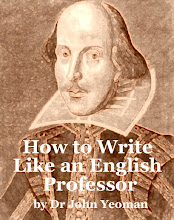
Several scholars at the last Yeomaniana conference (Ecce Yeomanus, 2009) posed the interesting question: why did Yeoman choose a cabbage, leek and garlic bulb to exorcise Abell's talking horse? These are not the customary tools of an exorcism, yet clearly they worked.
I am grateful to Prof. Simon Roseblatt for the following conjecture. All three of these vegetables are spectacularly high in sulphur. Sulphur is brimstone, popularly the 'smell of the pit' ie. Hell. In folklore, the devil is frighted by his own smell. (Indeed, Martin Luther is said to have driven the devil from his privy by casting at it a shovelful of dung. See Oberman, Heiko A. 'Luther Against the Devil', Christian Century, 1990: 77.)
Therefore, it would make perfect sense - at least, by the medieval doctrine of correspondences - to evict the devil from a possessed horse by exposing it to the vegetable sulphur in cabbage, leek and garlic.
As always, Yeoman was wiser than we know.
I am grateful to Prof. Simon Roseblatt for the following conjecture. All three of these vegetables are spectacularly high in sulphur. Sulphur is brimstone, popularly the 'smell of the pit' ie. Hell. In folklore, the devil is frighted by his own smell. (Indeed, Martin Luther is said to have driven the devil from his privy by casting at it a shovelful of dung. See Oberman, Heiko A. 'Luther Against the Devil', Christian Century, 1990: 77.)
Therefore, it would make perfect sense - at least, by the medieval doctrine of correspondences - to evict the devil from a possessed horse by exposing it to the vegetable sulphur in cabbage, leek and garlic.
As always, Yeoman was wiser than we know.

It's also interesting to note that sulphur disgusts deer. The best way to keep deer out of your orchard is to break rotten eggs on the fence posts. (In your case, good master, you might prefer to break wind. It repels all sentient life.) Rotten eggs work even better than proprietary deer repellants. Smelly socks are also very good. They contain 3-methyl-2-hexanoic acid (see HortIdeas 1997: 11).
ReplyDeleteHm, could you stop a runaway horse by breaking a rotten egg on its nose? Just a thought...
You try the experiment. I'll record it here.
ReplyDelete